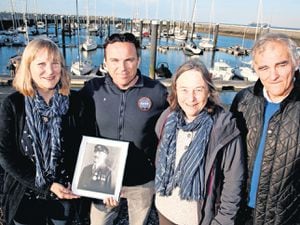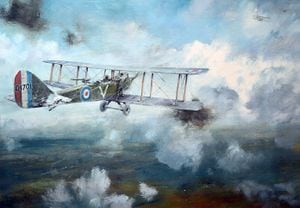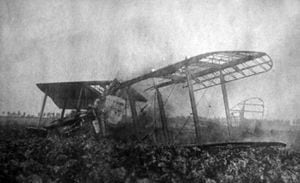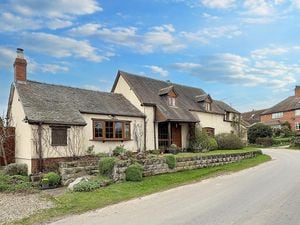Shropshire hero climbed on wing to save shattered plane
To a young Sally Dodwell, Thomas was her one-armed granddad with incredible stories – others knew him as a Shropshire hero who had climbed out onto the wing of his plane to keep it balanced.

As bedtime stories go, those given to the Sally were somewhat unusual.
"Gran would send him up to tell me a bedtime story and he would sometimes come up and tell me about some of his crashes," said Sally.
"Gran was very keen that things should be passed on. There were a lot of them. The planes in those days were horrendous things to go up in and you were as likely to crash when the engine went wrong as through being shot down by the enemy.
"He was amazingly lucky in that he had so many crashes and walked away from them – until the final one."
Her grandfather was Second Lieutenant Thomas Brierley Dodwell, a Shropshire airman of the Great War who was hailed a hero in national newspaper headlines for an exploit in which he climbed out on to a wing to keep the aircraft balanced for flying after half the tail had been shot off and the plane peppered with over 250 holes.
For that Bri, as he was known, who was the Observer in the DH9 biplane, was awarded the Distinguished Service Order and, unusually, also the American Distinguished Service Cross.
Just three days later his plane was shot down into the sea, landing in a minefield off the coast of neutral Holland, and his life was saved in a dramatic rescue by the lifeboat at Cadzand.
Brave
Last month his grandchildren went to the lifeboat station in the 100th anniversary year of those events to say thank you and to tell them that the family still remembered.
"It was my husband David's idea," said Sally, who is now Mrs Sally Moss and lives at Cruckmeole, near Shrewsbury.
"I'm really glad he suggested it. It's incredibly special to go, and it was really interesting."
The family who went were David and Sally, and Sally's brother Richard Dodwell and sister Clare Soltysiak.
They shook the hand of Bart Gorthmanns, whose great-grandfather Cees van de Heuvel was the lifeboat skipper on that fateful day, August 16, 1918. As the plane sank, van de Heuvel dived into the water and swam through the minefield and brought Bri back to the lifeboat. Bri was barely conscious and his arm had been shattered by anti-aircraft fire. It was later amputated in a Dutch hospital.
"Thank you, your great-grandfather was a brave man. Without him we would not be here," Clare told Bart.
Sally grew up knowing about her grandfather's deeds.
"I lived with my grandparents here at this house for quite a while – my parents were abroad in India – and I had been told as a child by them. My father was a tea planter in Assam.
"His medals were in the china cabinet and his citations were on the wall."

Sally was 18 when Bri died in April 1972 and remembers of him: "He had a real sense of humour. He was a tease. He was tall and thin with a moustache and he always wore a sports coat. The sleeve was always tucked in to the pocket on the one side because he only had one arm.
"He always picked up pebbles for the paths, everywhere he went."
At the time of the Great War his family home was The Day House at Cherrington, near Newport, and he went on to be a farmer there post-war.
"He was never really a happy farmer, I don't think his heart was in it. He wanted to be a racing driver apparently and he would have liked to have flown. He was into machines and things. He always had a Jag, and it was always an old one."
To change gear with one arm he would use the simple expedient of steering with his knees.
Bri spent the last 19 years of his life at Cruckmeole.
Some years ago Sally's late father Kim Dodwell commissioned a painting depicting the incident which brought his father, Second Lieutenant Dodwell, national fame.
During the Great War Bri first drove trucks for the Army before switching to the then Royal Flying Corps and becoming an Observer.
In April 1918 he was posted to 211 Squadron stationed near Dunkirk, flying photo reconnaissance and bombing missions in two-seater DH9s, and in the period before he was shot down completed 64 missions and survived four crashes and several forced landings. His aircraft was hit by anti-aircraft fire on 10 different occasions, and he was once stunned by a shell splinter.
For one raid on an enemy airfield in which he bombed an arms dump he was Mentioned in Despatches, and by the end of July 1918 was an experienced crew member, hailed by his commanding officer as one of the oldest – he was still only 21 – and best Observers.
He was recommended for the Distinguished Service Cross by his pilot, 1st Lieutenant Allan Bonnalie, an American who had volunteered for the RFC before America entered the war, for his act of "extraordinary heroism" on August 13, 1918. Under attack by a pack of Fokker biplanes near Bruges, Dodwell drove them off with his Lewis machine gun.

Bonnalie wrote: "Realising that the machine was out of control owing to the loss of lift in the tail plane, half of this being shot away, he left his cockpit and, climbing along the wing, lay down along the cowling in front of the pilot, enabling the latter to obtain partial control of the machine and head for home.
"When nearing the ground he climbed back into his cockpit to allow the nose to rise, and the pilot succeeded in safely landing. The presence of mind and cool courage of this officer undoubtedly saved the machine and deserved the highest praise."
In Dodwell's flying logbook he recorded: "Over 250 holes in bus, 8 in my cockpit... we were very lucky."
That luck ran out three days later on August 16 when, with a different pilot, Captain Wynne-Eyton, an anti-aircraft shall burst close to their plane, and he was hit in three places in his left arm, breaking it near the shoulder. To add to their troubles they were attacked by a German fighter which shot the bottom wing in two, and the aircraft went down in the sea just off the Dutch coast. Both were rescued.
He was to be interned in Holland for the rest of the war and returned to Shropshire to a hero's welcome. There was a barn dance in the granary at the Day House and a huge bonfire was lit on Shray Hill, where a silver birch was planted to mark the event.
However they are short-lived trees and, unlike memories of Second Lieutenant Dodwell's heroism, it has not endured.





